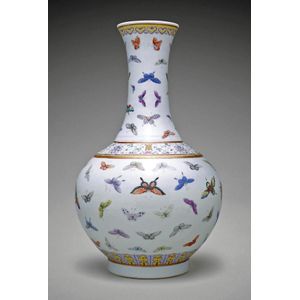Crackle Glaze Chinese Porcelain Kendi with Floral Decoration
You must be a subscriber, and be logged in to view price and dealer details.
Subscribe Now to view actual auction price for this item
When you subscribe, you have the option of setting the currency in which to display prices to $Au, $US, $NZ or Stg.
- Crackles / Cracquelure - In ceramics, crackles may be introduced intentionally during the firing process, as was often the case with Oriental ceramics, and are known as artificial crackles. Natural crackles occur with age, and if the glaze is transparent, may be difficult to detect. Natural crackles may not cover the whole surface of the object and may be uneven in size.
- Crackling and Crackle as a Decorative Technique - Crackle, also known as crackling, is a decorative technique that has been used in China for centuries. It is believed to have originated during the Song Dynasty (960?1279 AD) and was primarily used in the production of ceramics, lacquerware, and furniture. The crackling effect was achieved by applying a glaze or lacquer that was formulated to crack during firing, creating a crackled pattern on the surface of the item.
During the Ming Dynasty (1368?1644 AD), crackle became a highly sought-after decorative technique, and it was used to create intricate and beautiful designs on ceramics and lacquer ware.
In Western decorative arts, crackle / crackling came into use during the Art Nouveau movement in the late 19th and early 20th century. The crackling effect was used to create a sense of movement and fluidity in the design of Art Nouveau pieces.
It was also used in the 1920s and 1930s during the Art Deco movement.
This item has been included into following indexes:
Visually similar items

A Chinese decorative baluster vase with handpainted floral decoration in red, green, blue and yellow. Shun Chih mark to base. Height 19.5 cm

A Chinese porcelain bottle vase, seal mark to base, Daoguang 1820-1850, a long neck & globular body painted in overglaze enamel with flowering blooms & butterflies, the interior & base are enamelled in turquoise with a reserve in the centre with the iron r

A Chinese famille-rose 'butterfly' vase, Guangxu six-character iron-red mark, late Qing to Republic period, 39 cm high. Provenance: NSW Private Collection, purchased in 1989 in Hong Kong, Exhibitions and Publications: 'Innovation and Continuity: 20th centu

A Chinese export polychrome-decorated vase, late 19th/early 20th century, mallet-shaped with a flaring mouth and a chilong applied to the neck, reserves to the neck and body painted with scenes of figures on a terrace and with birds and insects amidst flow
